Economics Development Report: Role of Agriculture in Economic Growth
VerifiedAdded on 2021/04/16
|14
|3092
|171
Report
AI Summary
This report provides a comprehensive analysis of the agriculture sector's role in economic development, with a specific focus on Taiwan. It begins with an introduction to the key aspects of the agricultural sector and its contribution to a nation's economic and social aspects. The report then explores the Green Revolution, discussing its impact and the adoption of modern technologies. It also addresses setbacks and problems faced by the agricultural sector, such as sustainability issues and access to technology. A significant portion of the report is dedicated to the major agricultural policies of Taiwan, including land reform policies and marketing strategies. Finally, it presents an argument on the importance of agriculture in development policy, emphasizing its vital role in food security and employment. The report concludes with a summary of key findings and includes references and appendices.
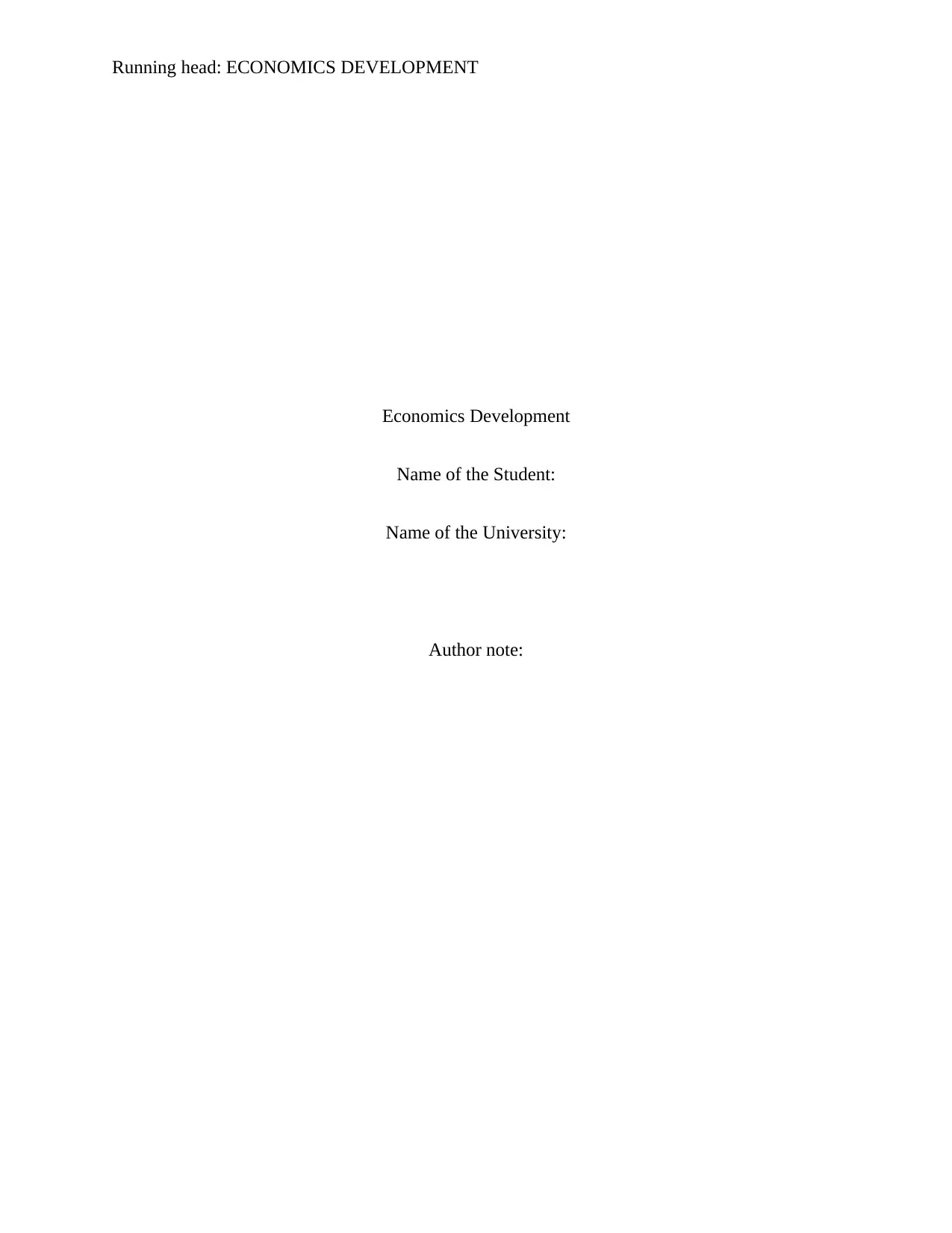
Running head: ECONOMICS DEVELOPMENT
Economics Development
Name of the Student:
Name of the University:
Author note:
Economics Development
Name of the Student:
Name of the University:
Author note:
Paraphrase This Document
Need a fresh take? Get an instant paraphrase of this document with our AI Paraphraser
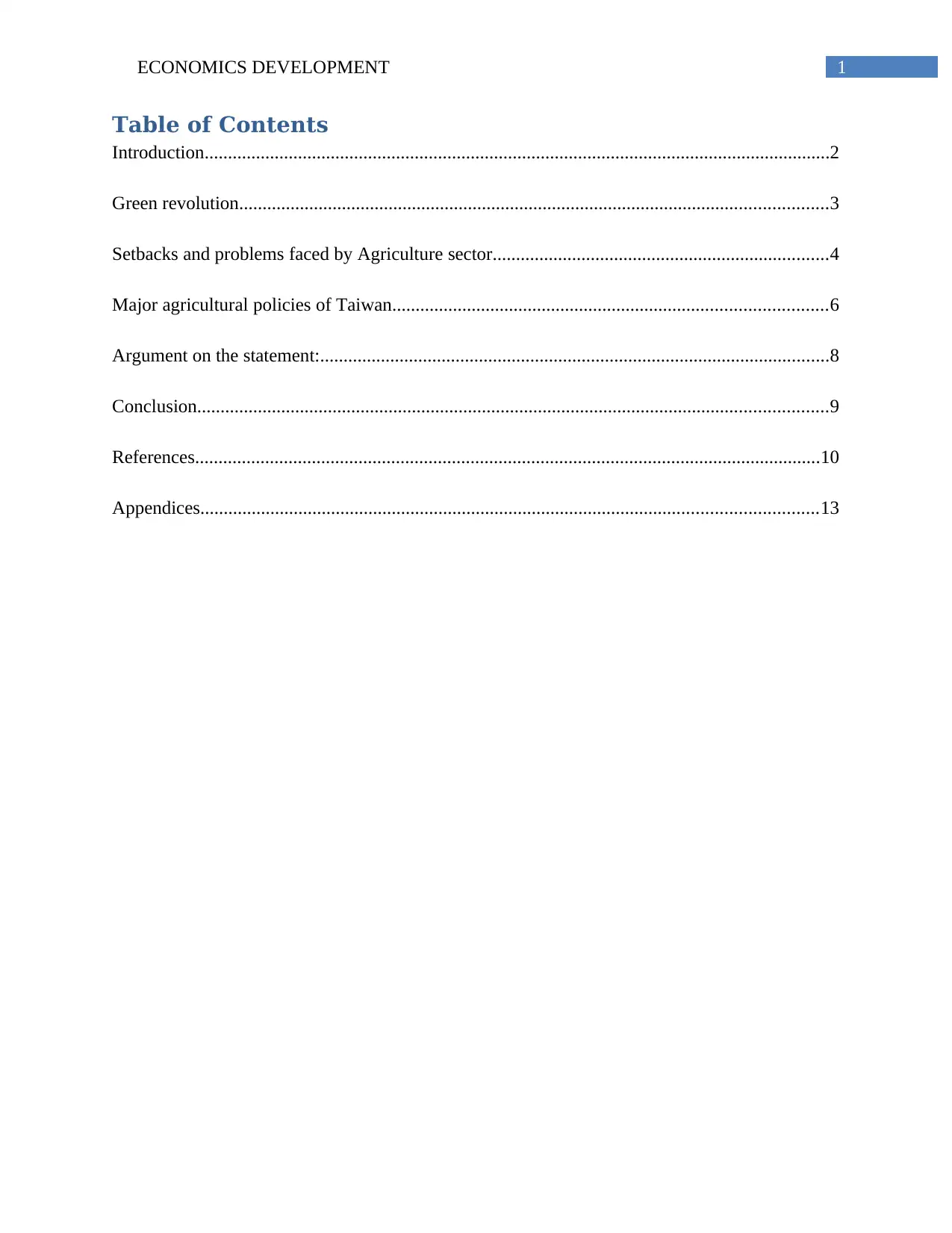
1ECONOMICS DEVELOPMENT
Table of Contents
Introduction......................................................................................................................................2
Green revolution..............................................................................................................................3
Setbacks and problems faced by Agriculture sector........................................................................4
Major agricultural policies of Taiwan.............................................................................................6
Argument on the statement:.............................................................................................................8
Conclusion.......................................................................................................................................9
References......................................................................................................................................10
Appendices....................................................................................................................................13
Table of Contents
Introduction......................................................................................................................................2
Green revolution..............................................................................................................................3
Setbacks and problems faced by Agriculture sector........................................................................4
Major agricultural policies of Taiwan.............................................................................................6
Argument on the statement:.............................................................................................................8
Conclusion.......................................................................................................................................9
References......................................................................................................................................10
Appendices....................................................................................................................................13
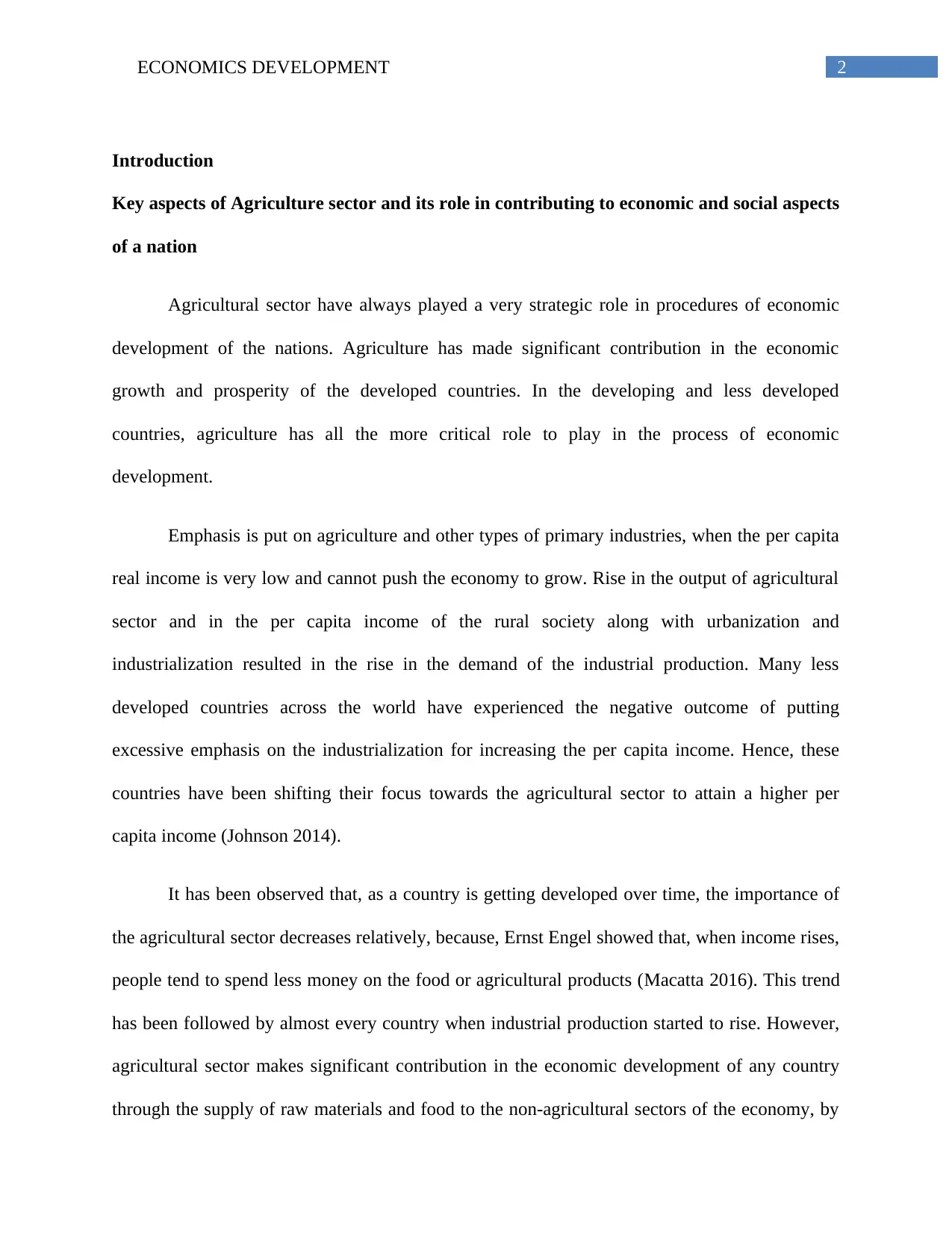
2ECONOMICS DEVELOPMENT
Introduction
Key aspects of Agriculture sector and its role in contributing to economic and social aspects
of a nation
Agricultural sector have always played a very strategic role in procedures of economic
development of the nations. Agriculture has made significant contribution in the economic
growth and prosperity of the developed countries. In the developing and less developed
countries, agriculture has all the more critical role to play in the process of economic
development.
Emphasis is put on agriculture and other types of primary industries, when the per capita
real income is very low and cannot push the economy to grow. Rise in the output of agricultural
sector and in the per capita income of the rural society along with urbanization and
industrialization resulted in the rise in the demand of the industrial production. Many less
developed countries across the world have experienced the negative outcome of putting
excessive emphasis on the industrialization for increasing the per capita income. Hence, these
countries have been shifting their focus towards the agricultural sector to attain a higher per
capita income (Johnson 2014).
It has been observed that, as a country is getting developed over time, the importance of
the agricultural sector decreases relatively, because, Ernst Engel showed that, when income rises,
people tend to spend less money on the food or agricultural products (Macatta 2016). This trend
has been followed by almost every country when industrial production started to rise. However,
agricultural sector makes significant contribution in the economic development of any country
through the supply of raw materials and food to the non-agricultural sectors of the economy, by
Introduction
Key aspects of Agriculture sector and its role in contributing to economic and social aspects
of a nation
Agricultural sector have always played a very strategic role in procedures of economic
development of the nations. Agriculture has made significant contribution in the economic
growth and prosperity of the developed countries. In the developing and less developed
countries, agriculture has all the more critical role to play in the process of economic
development.
Emphasis is put on agriculture and other types of primary industries, when the per capita
real income is very low and cannot push the economy to grow. Rise in the output of agricultural
sector and in the per capita income of the rural society along with urbanization and
industrialization resulted in the rise in the demand of the industrial production. Many less
developed countries across the world have experienced the negative outcome of putting
excessive emphasis on the industrialization for increasing the per capita income. Hence, these
countries have been shifting their focus towards the agricultural sector to attain a higher per
capita income (Johnson 2014).
It has been observed that, as a country is getting developed over time, the importance of
the agricultural sector decreases relatively, because, Ernst Engel showed that, when income rises,
people tend to spend less money on the food or agricultural products (Macatta 2016). This trend
has been followed by almost every country when industrial production started to rise. However,
agricultural sector makes significant contribution in the economic development of any country
through the supply of raw materials and food to the non-agricultural sectors of the economy, by
⊘ This is a preview!⊘
Do you want full access?
Subscribe today to unlock all pages.

Trusted by 1+ million students worldwide
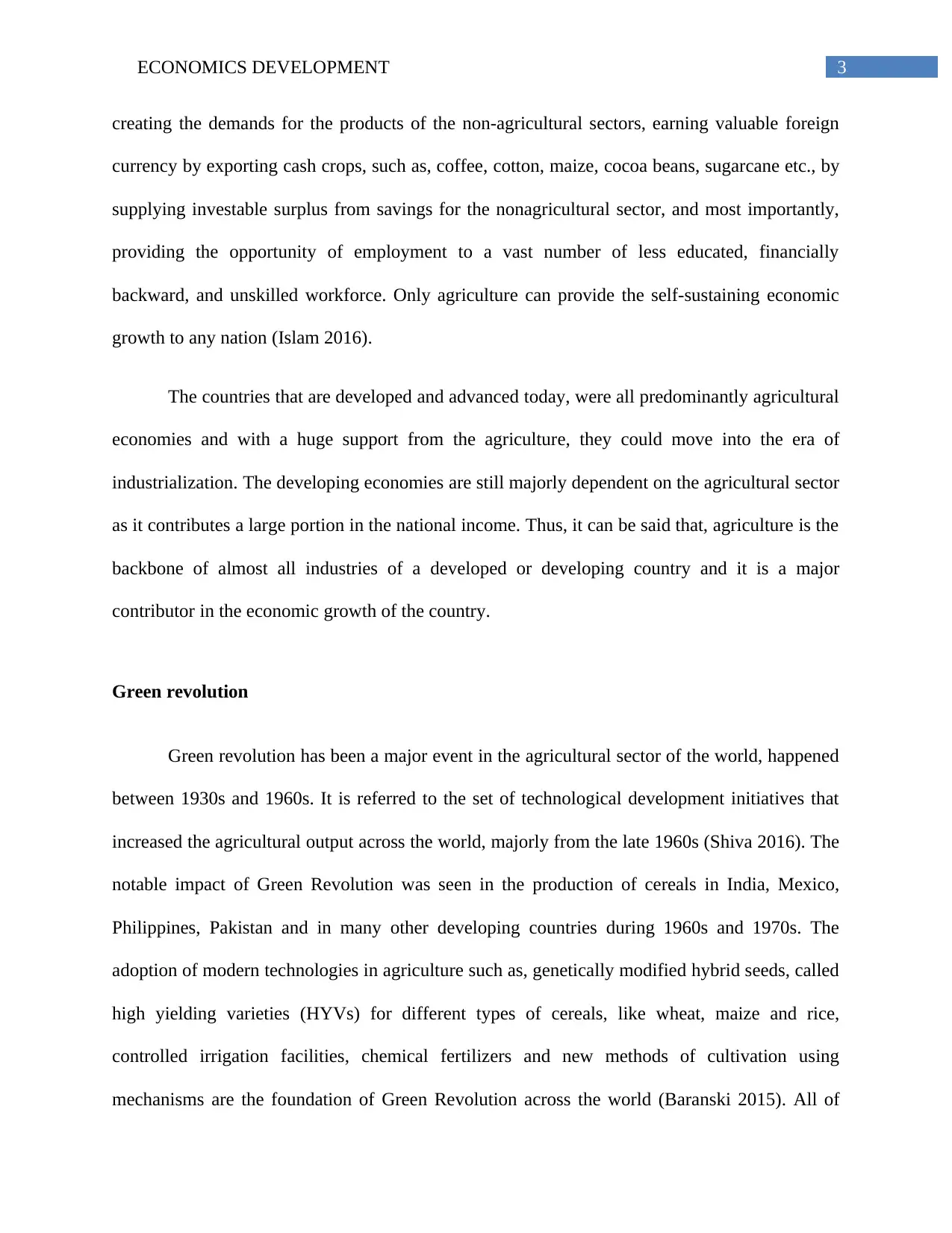
3ECONOMICS DEVELOPMENT
creating the demands for the products of the non-agricultural sectors, earning valuable foreign
currency by exporting cash crops, such as, coffee, cotton, maize, cocoa beans, sugarcane etc., by
supplying investable surplus from savings for the nonagricultural sector, and most importantly,
providing the opportunity of employment to a vast number of less educated, financially
backward, and unskilled workforce. Only agriculture can provide the self-sustaining economic
growth to any nation (Islam 2016).
The countries that are developed and advanced today, were all predominantly agricultural
economies and with a huge support from the agriculture, they could move into the era of
industrialization. The developing economies are still majorly dependent on the agricultural sector
as it contributes a large portion in the national income. Thus, it can be said that, agriculture is the
backbone of almost all industries of a developed or developing country and it is a major
contributor in the economic growth of the country.
Green revolution
Green revolution has been a major event in the agricultural sector of the world, happened
between 1930s and 1960s. It is referred to the set of technological development initiatives that
increased the agricultural output across the world, majorly from the late 1960s (Shiva 2016). The
notable impact of Green Revolution was seen in the production of cereals in India, Mexico,
Philippines, Pakistan and in many other developing countries during 1960s and 1970s. The
adoption of modern technologies in agriculture such as, genetically modified hybrid seeds, called
high yielding varieties (HYVs) for different types of cereals, like wheat, maize and rice,
controlled irrigation facilities, chemical fertilizers and new methods of cultivation using
mechanisms are the foundation of Green Revolution across the world (Baranski 2015). All of
creating the demands for the products of the non-agricultural sectors, earning valuable foreign
currency by exporting cash crops, such as, coffee, cotton, maize, cocoa beans, sugarcane etc., by
supplying investable surplus from savings for the nonagricultural sector, and most importantly,
providing the opportunity of employment to a vast number of less educated, financially
backward, and unskilled workforce. Only agriculture can provide the self-sustaining economic
growth to any nation (Islam 2016).
The countries that are developed and advanced today, were all predominantly agricultural
economies and with a huge support from the agriculture, they could move into the era of
industrialization. The developing economies are still majorly dependent on the agricultural sector
as it contributes a large portion in the national income. Thus, it can be said that, agriculture is the
backbone of almost all industries of a developed or developing country and it is a major
contributor in the economic growth of the country.
Green revolution
Green revolution has been a major event in the agricultural sector of the world, happened
between 1930s and 1960s. It is referred to the set of technological development initiatives that
increased the agricultural output across the world, majorly from the late 1960s (Shiva 2016). The
notable impact of Green Revolution was seen in the production of cereals in India, Mexico,
Philippines, Pakistan and in many other developing countries during 1960s and 1970s. The
adoption of modern technologies in agriculture such as, genetically modified hybrid seeds, called
high yielding varieties (HYVs) for different types of cereals, like wheat, maize and rice,
controlled irrigation facilities, chemical fertilizers and new methods of cultivation using
mechanisms are the foundation of Green Revolution across the world (Baranski 2015). All of
Paraphrase This Document
Need a fresh take? Get an instant paraphrase of this document with our AI Paraphraser
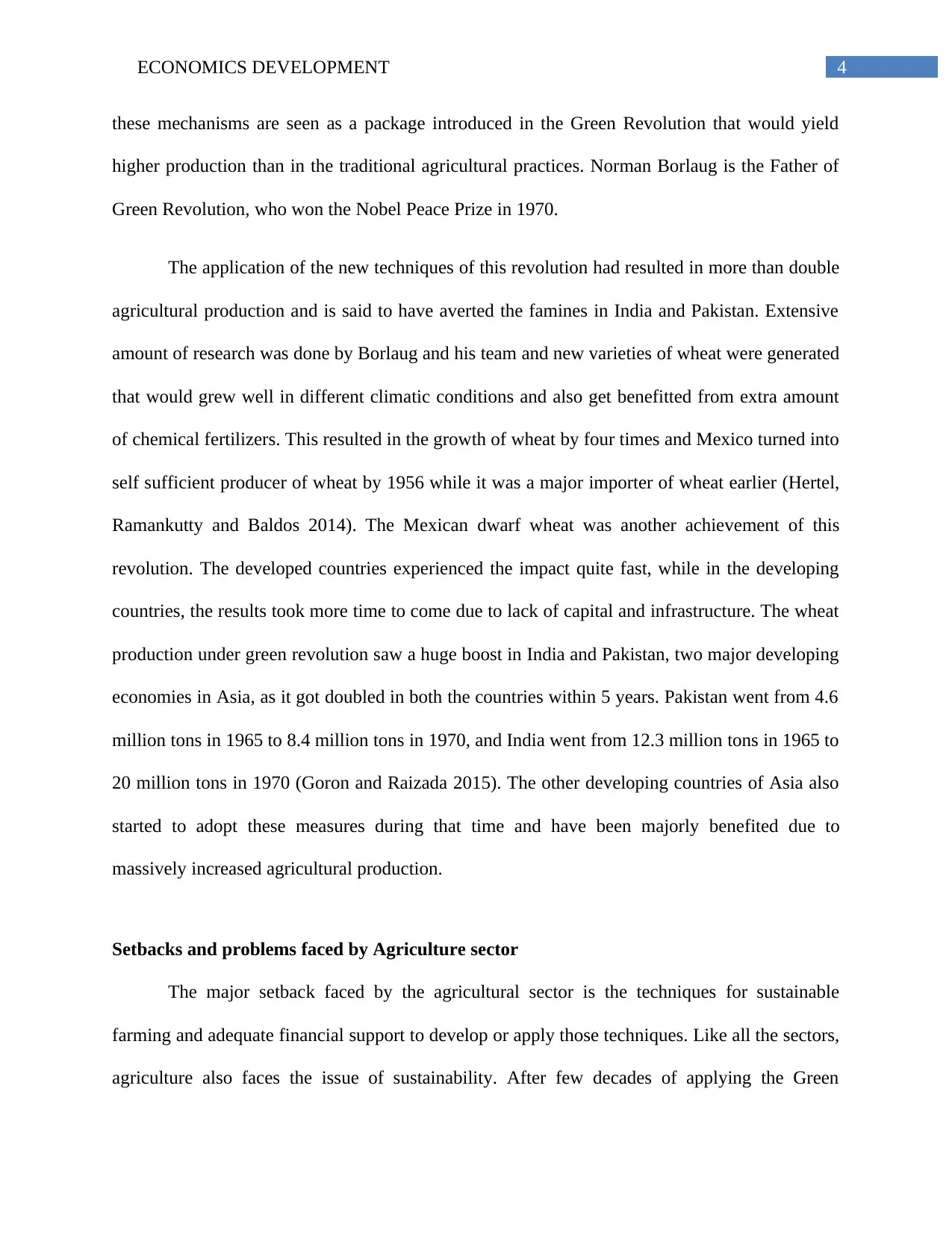
4ECONOMICS DEVELOPMENT
these mechanisms are seen as a package introduced in the Green Revolution that would yield
higher production than in the traditional agricultural practices. Norman Borlaug is the Father of
Green Revolution, who won the Nobel Peace Prize in 1970.
The application of the new techniques of this revolution had resulted in more than double
agricultural production and is said to have averted the famines in India and Pakistan. Extensive
amount of research was done by Borlaug and his team and new varieties of wheat were generated
that would grew well in different climatic conditions and also get benefitted from extra amount
of chemical fertilizers. This resulted in the growth of wheat by four times and Mexico turned into
self sufficient producer of wheat by 1956 while it was a major importer of wheat earlier (Hertel,
Ramankutty and Baldos 2014). The Mexican dwarf wheat was another achievement of this
revolution. The developed countries experienced the impact quite fast, while in the developing
countries, the results took more time to come due to lack of capital and infrastructure. The wheat
production under green revolution saw a huge boost in India and Pakistan, two major developing
economies in Asia, as it got doubled in both the countries within 5 years. Pakistan went from 4.6
million tons in 1965 to 8.4 million tons in 1970, and India went from 12.3 million tons in 1965 to
20 million tons in 1970 (Goron and Raizada 2015). The other developing countries of Asia also
started to adopt these measures during that time and have been majorly benefited due to
massively increased agricultural production.
Setbacks and problems faced by Agriculture sector
The major setback faced by the agricultural sector is the techniques for sustainable
farming and adequate financial support to develop or apply those techniques. Like all the sectors,
agriculture also faces the issue of sustainability. After few decades of applying the Green
these mechanisms are seen as a package introduced in the Green Revolution that would yield
higher production than in the traditional agricultural practices. Norman Borlaug is the Father of
Green Revolution, who won the Nobel Peace Prize in 1970.
The application of the new techniques of this revolution had resulted in more than double
agricultural production and is said to have averted the famines in India and Pakistan. Extensive
amount of research was done by Borlaug and his team and new varieties of wheat were generated
that would grew well in different climatic conditions and also get benefitted from extra amount
of chemical fertilizers. This resulted in the growth of wheat by four times and Mexico turned into
self sufficient producer of wheat by 1956 while it was a major importer of wheat earlier (Hertel,
Ramankutty and Baldos 2014). The Mexican dwarf wheat was another achievement of this
revolution. The developed countries experienced the impact quite fast, while in the developing
countries, the results took more time to come due to lack of capital and infrastructure. The wheat
production under green revolution saw a huge boost in India and Pakistan, two major developing
economies in Asia, as it got doubled in both the countries within 5 years. Pakistan went from 4.6
million tons in 1965 to 8.4 million tons in 1970, and India went from 12.3 million tons in 1965 to
20 million tons in 1970 (Goron and Raizada 2015). The other developing countries of Asia also
started to adopt these measures during that time and have been majorly benefited due to
massively increased agricultural production.
Setbacks and problems faced by Agriculture sector
The major setback faced by the agricultural sector is the techniques for sustainable
farming and adequate financial support to develop or apply those techniques. Like all the sectors,
agriculture also faces the issue of sustainability. After few decades of applying the Green
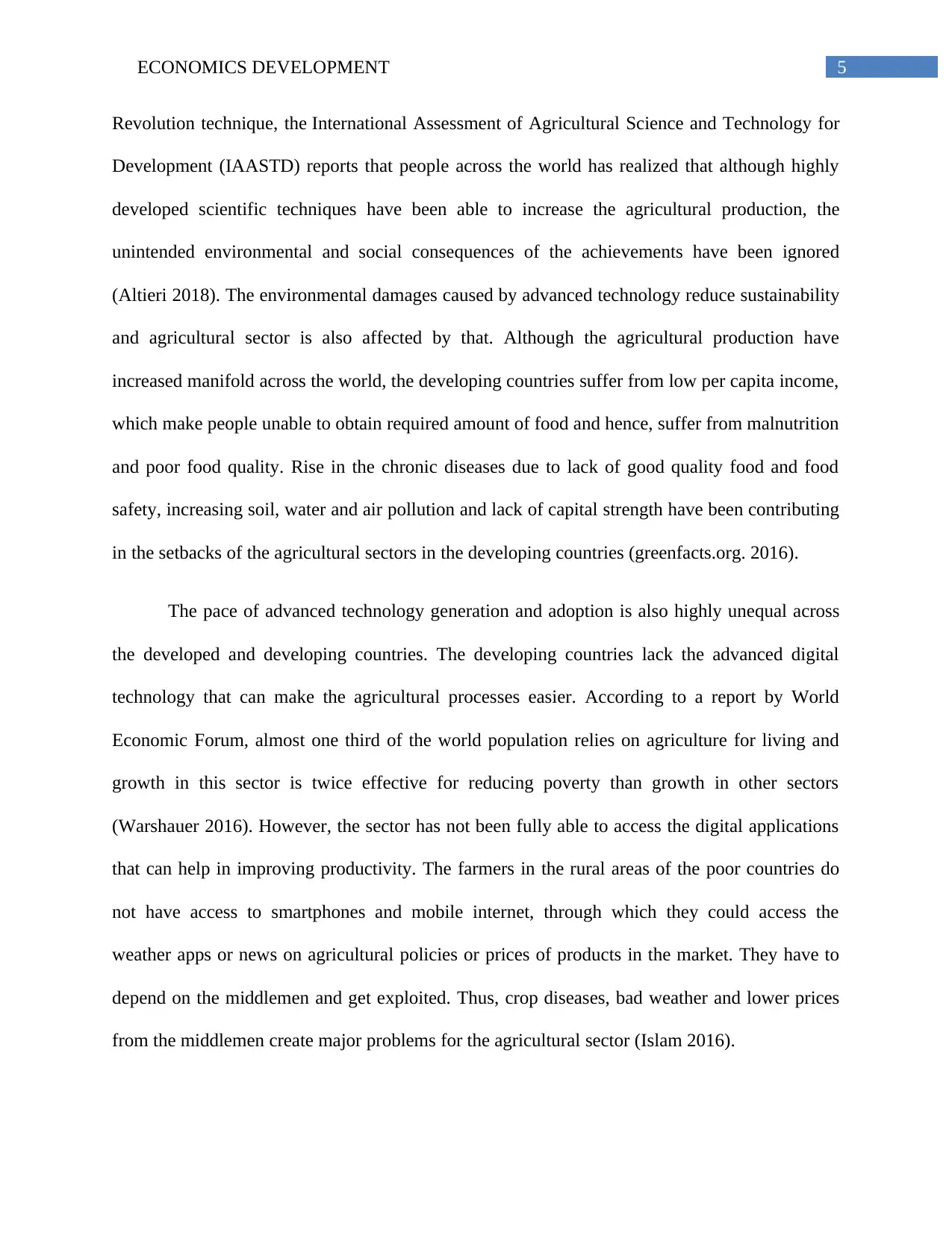
5ECONOMICS DEVELOPMENT
Revolution technique, the International Assessment of Agricultural Science and Technology for
Development (IAASTD) reports that people across the world has realized that although highly
developed scientific techniques have been able to increase the agricultural production, the
unintended environmental and social consequences of the achievements have been ignored
(Altieri 2018). The environmental damages caused by advanced technology reduce sustainability
and agricultural sector is also affected by that. Although the agricultural production have
increased manifold across the world, the developing countries suffer from low per capita income,
which make people unable to obtain required amount of food and hence, suffer from malnutrition
and poor food quality. Rise in the chronic diseases due to lack of good quality food and food
safety, increasing soil, water and air pollution and lack of capital strength have been contributing
in the setbacks of the agricultural sectors in the developing countries (greenfacts.org. 2016).
The pace of advanced technology generation and adoption is also highly unequal across
the developed and developing countries. The developing countries lack the advanced digital
technology that can make the agricultural processes easier. According to a report by World
Economic Forum, almost one third of the world population relies on agriculture for living and
growth in this sector is twice effective for reducing poverty than growth in other sectors
(Warshauer 2016). However, the sector has not been fully able to access the digital applications
that can help in improving productivity. The farmers in the rural areas of the poor countries do
not have access to smartphones and mobile internet, through which they could access the
weather apps or news on agricultural policies or prices of products in the market. They have to
depend on the middlemen and get exploited. Thus, crop diseases, bad weather and lower prices
from the middlemen create major problems for the agricultural sector (Islam 2016).
Revolution technique, the International Assessment of Agricultural Science and Technology for
Development (IAASTD) reports that people across the world has realized that although highly
developed scientific techniques have been able to increase the agricultural production, the
unintended environmental and social consequences of the achievements have been ignored
(Altieri 2018). The environmental damages caused by advanced technology reduce sustainability
and agricultural sector is also affected by that. Although the agricultural production have
increased manifold across the world, the developing countries suffer from low per capita income,
which make people unable to obtain required amount of food and hence, suffer from malnutrition
and poor food quality. Rise in the chronic diseases due to lack of good quality food and food
safety, increasing soil, water and air pollution and lack of capital strength have been contributing
in the setbacks of the agricultural sectors in the developing countries (greenfacts.org. 2016).
The pace of advanced technology generation and adoption is also highly unequal across
the developed and developing countries. The developing countries lack the advanced digital
technology that can make the agricultural processes easier. According to a report by World
Economic Forum, almost one third of the world population relies on agriculture for living and
growth in this sector is twice effective for reducing poverty than growth in other sectors
(Warshauer 2016). However, the sector has not been fully able to access the digital applications
that can help in improving productivity. The farmers in the rural areas of the poor countries do
not have access to smartphones and mobile internet, through which they could access the
weather apps or news on agricultural policies or prices of products in the market. They have to
depend on the middlemen and get exploited. Thus, crop diseases, bad weather and lower prices
from the middlemen create major problems for the agricultural sector (Islam 2016).
⊘ This is a preview!⊘
Do you want full access?
Subscribe today to unlock all pages.

Trusted by 1+ million students worldwide
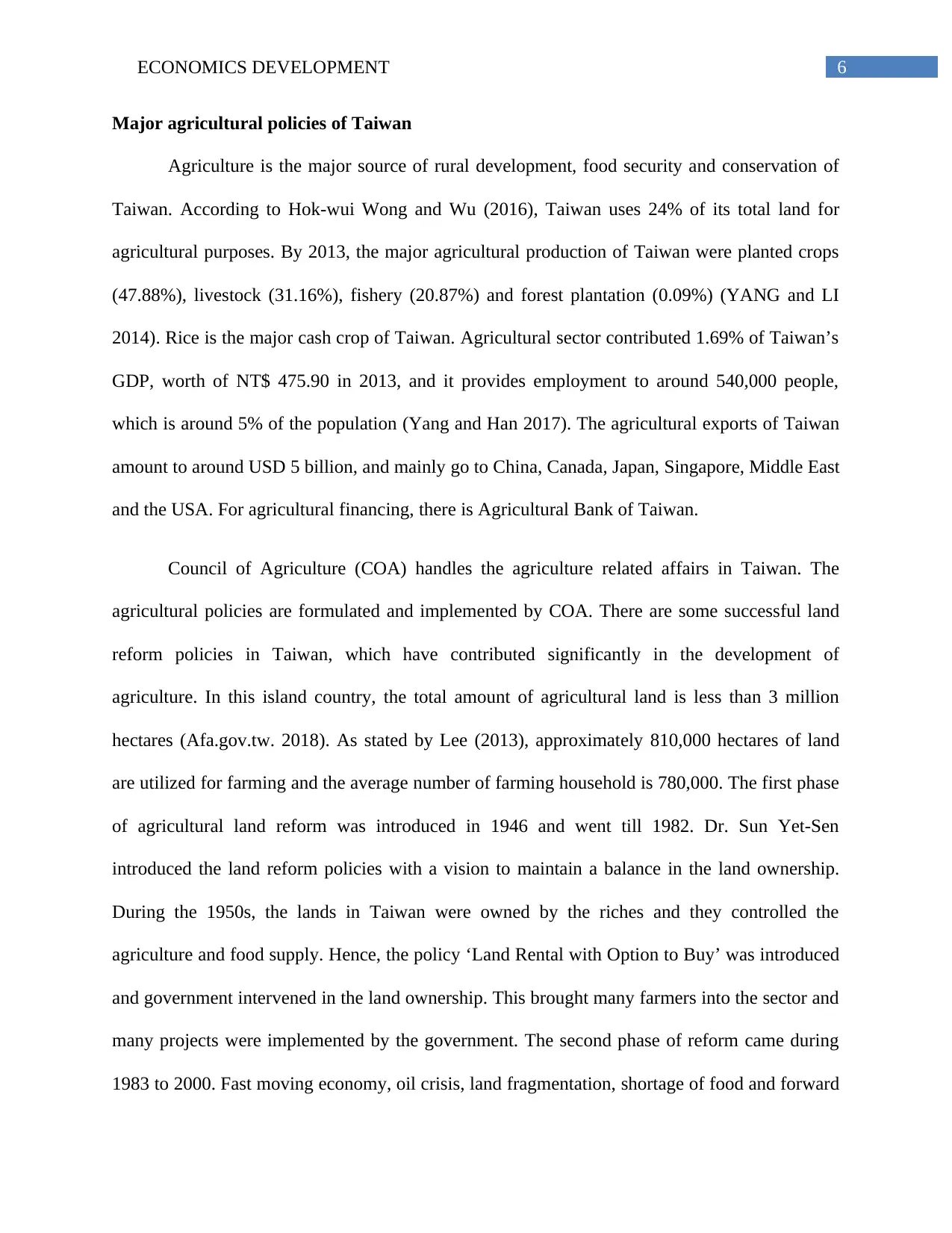
6ECONOMICS DEVELOPMENT
Major agricultural policies of Taiwan
Agriculture is the major source of rural development, food security and conservation of
Taiwan. According to Hok-wui Wong and Wu (2016), Taiwan uses 24% of its total land for
agricultural purposes. By 2013, the major agricultural production of Taiwan were planted crops
(47.88%), livestock (31.16%), fishery (20.87%) and forest plantation (0.09%) (YANG and LI
2014). Rice is the major cash crop of Taiwan. Agricultural sector contributed 1.69% of Taiwan’s
GDP, worth of NT$ 475.90 in 2013, and it provides employment to around 540,000 people,
which is around 5% of the population (Yang and Han 2017). The agricultural exports of Taiwan
amount to around USD 5 billion, and mainly go to China, Canada, Japan, Singapore, Middle East
and the USA. For agricultural financing, there is Agricultural Bank of Taiwan.
Council of Agriculture (COA) handles the agriculture related affairs in Taiwan. The
agricultural policies are formulated and implemented by COA. There are some successful land
reform policies in Taiwan, which have contributed significantly in the development of
agriculture. In this island country, the total amount of agricultural land is less than 3 million
hectares (Afa.gov.tw. 2018). As stated by Lee (2013), approximately 810,000 hectares of land
are utilized for farming and the average number of farming household is 780,000. The first phase
of agricultural land reform was introduced in 1946 and went till 1982. Dr. Sun Yet-Sen
introduced the land reform policies with a vision to maintain a balance in the land ownership.
During the 1950s, the lands in Taiwan were owned by the riches and they controlled the
agriculture and food supply. Hence, the policy ‘Land Rental with Option to Buy’ was introduced
and government intervened in the land ownership. This brought many farmers into the sector and
many projects were implemented by the government. The second phase of reform came during
1983 to 2000. Fast moving economy, oil crisis, land fragmentation, shortage of food and forward
Major agricultural policies of Taiwan
Agriculture is the major source of rural development, food security and conservation of
Taiwan. According to Hok-wui Wong and Wu (2016), Taiwan uses 24% of its total land for
agricultural purposes. By 2013, the major agricultural production of Taiwan were planted crops
(47.88%), livestock (31.16%), fishery (20.87%) and forest plantation (0.09%) (YANG and LI
2014). Rice is the major cash crop of Taiwan. Agricultural sector contributed 1.69% of Taiwan’s
GDP, worth of NT$ 475.90 in 2013, and it provides employment to around 540,000 people,
which is around 5% of the population (Yang and Han 2017). The agricultural exports of Taiwan
amount to around USD 5 billion, and mainly go to China, Canada, Japan, Singapore, Middle East
and the USA. For agricultural financing, there is Agricultural Bank of Taiwan.
Council of Agriculture (COA) handles the agriculture related affairs in Taiwan. The
agricultural policies are formulated and implemented by COA. There are some successful land
reform policies in Taiwan, which have contributed significantly in the development of
agriculture. In this island country, the total amount of agricultural land is less than 3 million
hectares (Afa.gov.tw. 2018). As stated by Lee (2013), approximately 810,000 hectares of land
are utilized for farming and the average number of farming household is 780,000. The first phase
of agricultural land reform was introduced in 1946 and went till 1982. Dr. Sun Yet-Sen
introduced the land reform policies with a vision to maintain a balance in the land ownership.
During the 1950s, the lands in Taiwan were owned by the riches and they controlled the
agriculture and food supply. Hence, the policy ‘Land Rental with Option to Buy’ was introduced
and government intervened in the land ownership. This brought many farmers into the sector and
many projects were implemented by the government. The second phase of reform came during
1983 to 2000. Fast moving economy, oil crisis, land fragmentation, shortage of food and forward
Paraphrase This Document
Need a fresh take? Get an instant paraphrase of this document with our AI Paraphraser
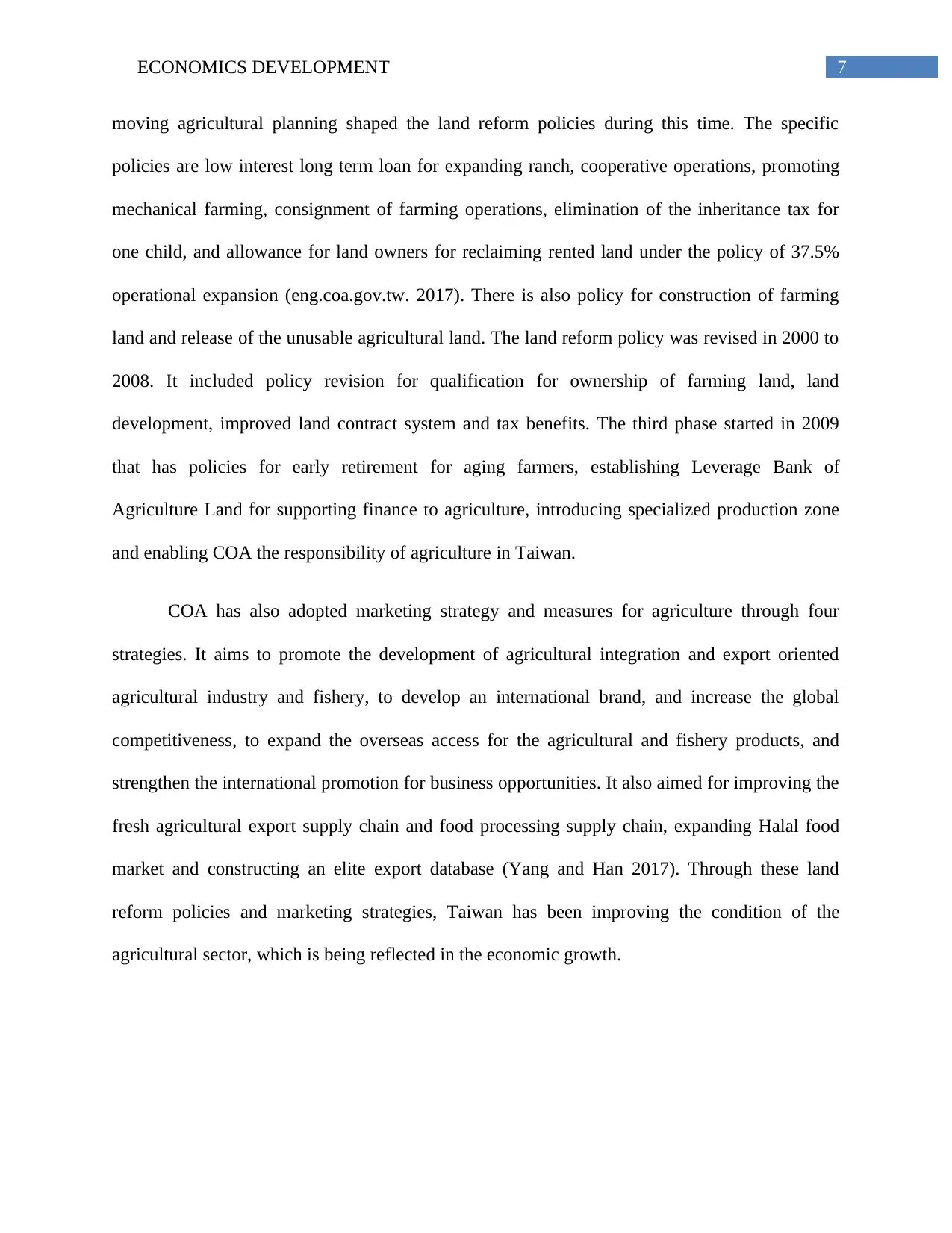
7ECONOMICS DEVELOPMENT
moving agricultural planning shaped the land reform policies during this time. The specific
policies are low interest long term loan for expanding ranch, cooperative operations, promoting
mechanical farming, consignment of farming operations, elimination of the inheritance tax for
one child, and allowance for land owners for reclaiming rented land under the policy of 37.5%
operational expansion (eng.coa.gov.tw. 2017). There is also policy for construction of farming
land and release of the unusable agricultural land. The land reform policy was revised in 2000 to
2008. It included policy revision for qualification for ownership of farming land, land
development, improved land contract system and tax benefits. The third phase started in 2009
that has policies for early retirement for aging farmers, establishing Leverage Bank of
Agriculture Land for supporting finance to agriculture, introducing specialized production zone
and enabling COA the responsibility of agriculture in Taiwan.
COA has also adopted marketing strategy and measures for agriculture through four
strategies. It aims to promote the development of agricultural integration and export oriented
agricultural industry and fishery, to develop an international brand, and increase the global
competitiveness, to expand the overseas access for the agricultural and fishery products, and
strengthen the international promotion for business opportunities. It also aimed for improving the
fresh agricultural export supply chain and food processing supply chain, expanding Halal food
market and constructing an elite export database (Yang and Han 2017). Through these land
reform policies and marketing strategies, Taiwan has been improving the condition of the
agricultural sector, which is being reflected in the economic growth.
moving agricultural planning shaped the land reform policies during this time. The specific
policies are low interest long term loan for expanding ranch, cooperative operations, promoting
mechanical farming, consignment of farming operations, elimination of the inheritance tax for
one child, and allowance for land owners for reclaiming rented land under the policy of 37.5%
operational expansion (eng.coa.gov.tw. 2017). There is also policy for construction of farming
land and release of the unusable agricultural land. The land reform policy was revised in 2000 to
2008. It included policy revision for qualification for ownership of farming land, land
development, improved land contract system and tax benefits. The third phase started in 2009
that has policies for early retirement for aging farmers, establishing Leverage Bank of
Agriculture Land for supporting finance to agriculture, introducing specialized production zone
and enabling COA the responsibility of agriculture in Taiwan.
COA has also adopted marketing strategy and measures for agriculture through four
strategies. It aims to promote the development of agricultural integration and export oriented
agricultural industry and fishery, to develop an international brand, and increase the global
competitiveness, to expand the overseas access for the agricultural and fishery products, and
strengthen the international promotion for business opportunities. It also aimed for improving the
fresh agricultural export supply chain and food processing supply chain, expanding Halal food
market and constructing an elite export database (Yang and Han 2017). Through these land
reform policies and marketing strategies, Taiwan has been improving the condition of the
agricultural sector, which is being reflected in the economic growth.
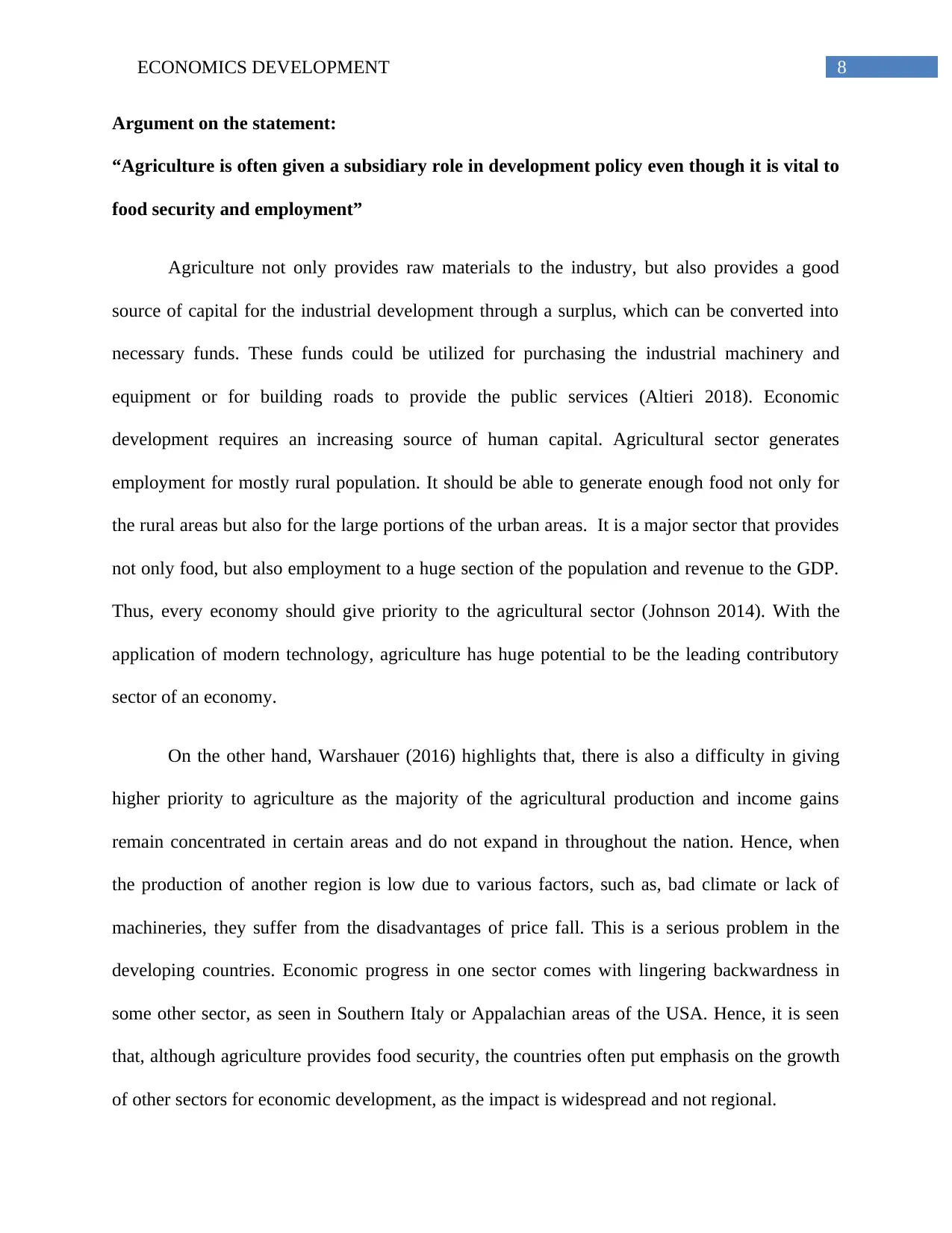
8ECONOMICS DEVELOPMENT
Argument on the statement:
“Agriculture is often given a subsidiary role in development policy even though it is vital to
food security and employment”
Agriculture not only provides raw materials to the industry, but also provides a good
source of capital for the industrial development through a surplus, which can be converted into
necessary funds. These funds could be utilized for purchasing the industrial machinery and
equipment or for building roads to provide the public services (Altieri 2018). Economic
development requires an increasing source of human capital. Agricultural sector generates
employment for mostly rural population. It should be able to generate enough food not only for
the rural areas but also for the large portions of the urban areas. It is a major sector that provides
not only food, but also employment to a huge section of the population and revenue to the GDP.
Thus, every economy should give priority to the agricultural sector (Johnson 2014). With the
application of modern technology, agriculture has huge potential to be the leading contributory
sector of an economy.
On the other hand, Warshauer (2016) highlights that, there is also a difficulty in giving
higher priority to agriculture as the majority of the agricultural production and income gains
remain concentrated in certain areas and do not expand in throughout the nation. Hence, when
the production of another region is low due to various factors, such as, bad climate or lack of
machineries, they suffer from the disadvantages of price fall. This is a serious problem in the
developing countries. Economic progress in one sector comes with lingering backwardness in
some other sector, as seen in Southern Italy or Appalachian areas of the USA. Hence, it is seen
that, although agriculture provides food security, the countries often put emphasis on the growth
of other sectors for economic development, as the impact is widespread and not regional.
Argument on the statement:
“Agriculture is often given a subsidiary role in development policy even though it is vital to
food security and employment”
Agriculture not only provides raw materials to the industry, but also provides a good
source of capital for the industrial development through a surplus, which can be converted into
necessary funds. These funds could be utilized for purchasing the industrial machinery and
equipment or for building roads to provide the public services (Altieri 2018). Economic
development requires an increasing source of human capital. Agricultural sector generates
employment for mostly rural population. It should be able to generate enough food not only for
the rural areas but also for the large portions of the urban areas. It is a major sector that provides
not only food, but also employment to a huge section of the population and revenue to the GDP.
Thus, every economy should give priority to the agricultural sector (Johnson 2014). With the
application of modern technology, agriculture has huge potential to be the leading contributory
sector of an economy.
On the other hand, Warshauer (2016) highlights that, there is also a difficulty in giving
higher priority to agriculture as the majority of the agricultural production and income gains
remain concentrated in certain areas and do not expand in throughout the nation. Hence, when
the production of another region is low due to various factors, such as, bad climate or lack of
machineries, they suffer from the disadvantages of price fall. This is a serious problem in the
developing countries. Economic progress in one sector comes with lingering backwardness in
some other sector, as seen in Southern Italy or Appalachian areas of the USA. Hence, it is seen
that, although agriculture provides food security, the countries often put emphasis on the growth
of other sectors for economic development, as the impact is widespread and not regional.
⊘ This is a preview!⊘
Do you want full access?
Subscribe today to unlock all pages.

Trusted by 1+ million students worldwide
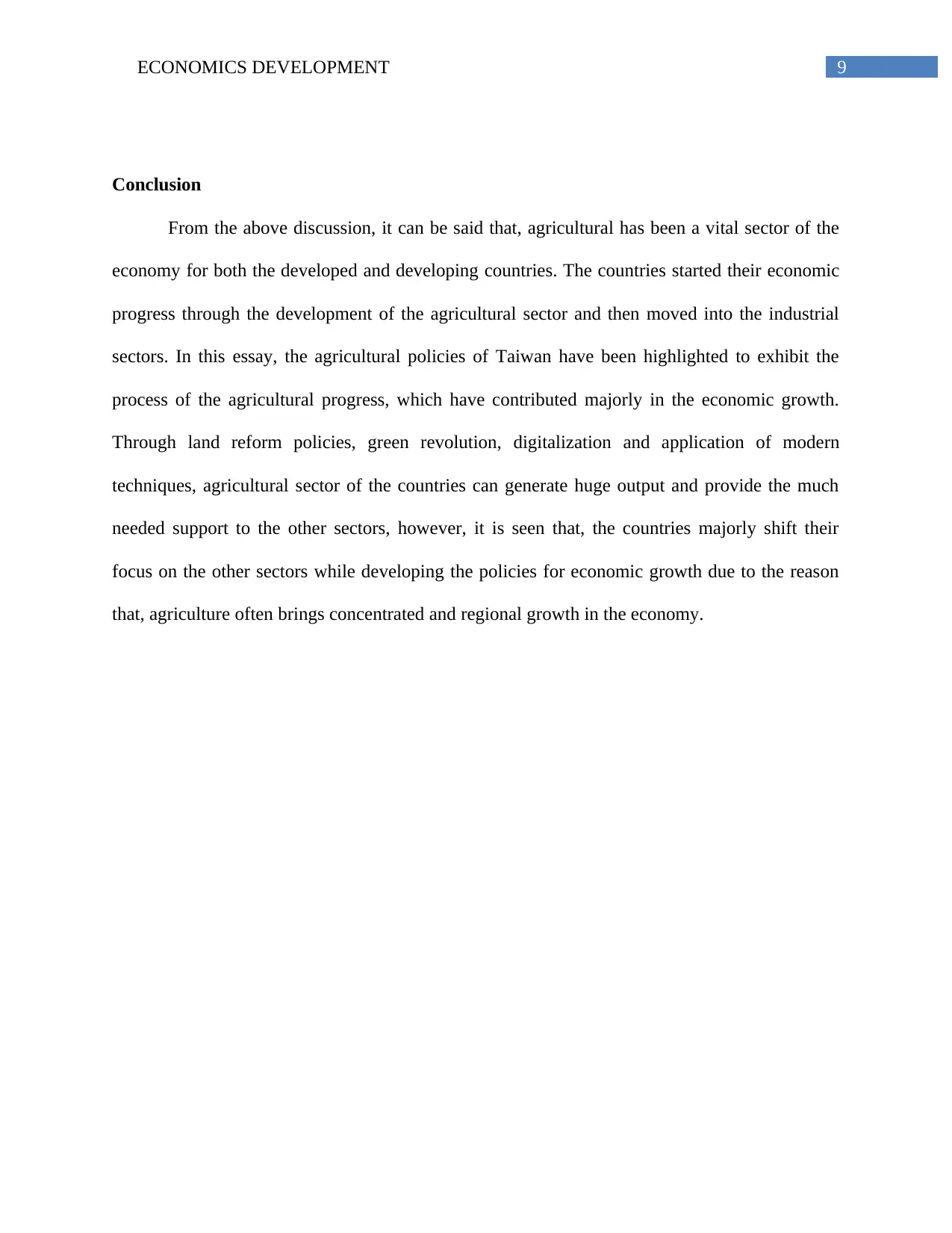
9ECONOMICS DEVELOPMENT
Conclusion
From the above discussion, it can be said that, agricultural has been a vital sector of the
economy for both the developed and developing countries. The countries started their economic
progress through the development of the agricultural sector and then moved into the industrial
sectors. In this essay, the agricultural policies of Taiwan have been highlighted to exhibit the
process of the agricultural progress, which have contributed majorly in the economic growth.
Through land reform policies, green revolution, digitalization and application of modern
techniques, agricultural sector of the countries can generate huge output and provide the much
needed support to the other sectors, however, it is seen that, the countries majorly shift their
focus on the other sectors while developing the policies for economic growth due to the reason
that, agriculture often brings concentrated and regional growth in the economy.
Conclusion
From the above discussion, it can be said that, agricultural has been a vital sector of the
economy for both the developed and developing countries. The countries started their economic
progress through the development of the agricultural sector and then moved into the industrial
sectors. In this essay, the agricultural policies of Taiwan have been highlighted to exhibit the
process of the agricultural progress, which have contributed majorly in the economic growth.
Through land reform policies, green revolution, digitalization and application of modern
techniques, agricultural sector of the countries can generate huge output and provide the much
needed support to the other sectors, however, it is seen that, the countries majorly shift their
focus on the other sectors while developing the policies for economic growth due to the reason
that, agriculture often brings concentrated and regional growth in the economy.
Paraphrase This Document
Need a fresh take? Get an instant paraphrase of this document with our AI Paraphraser
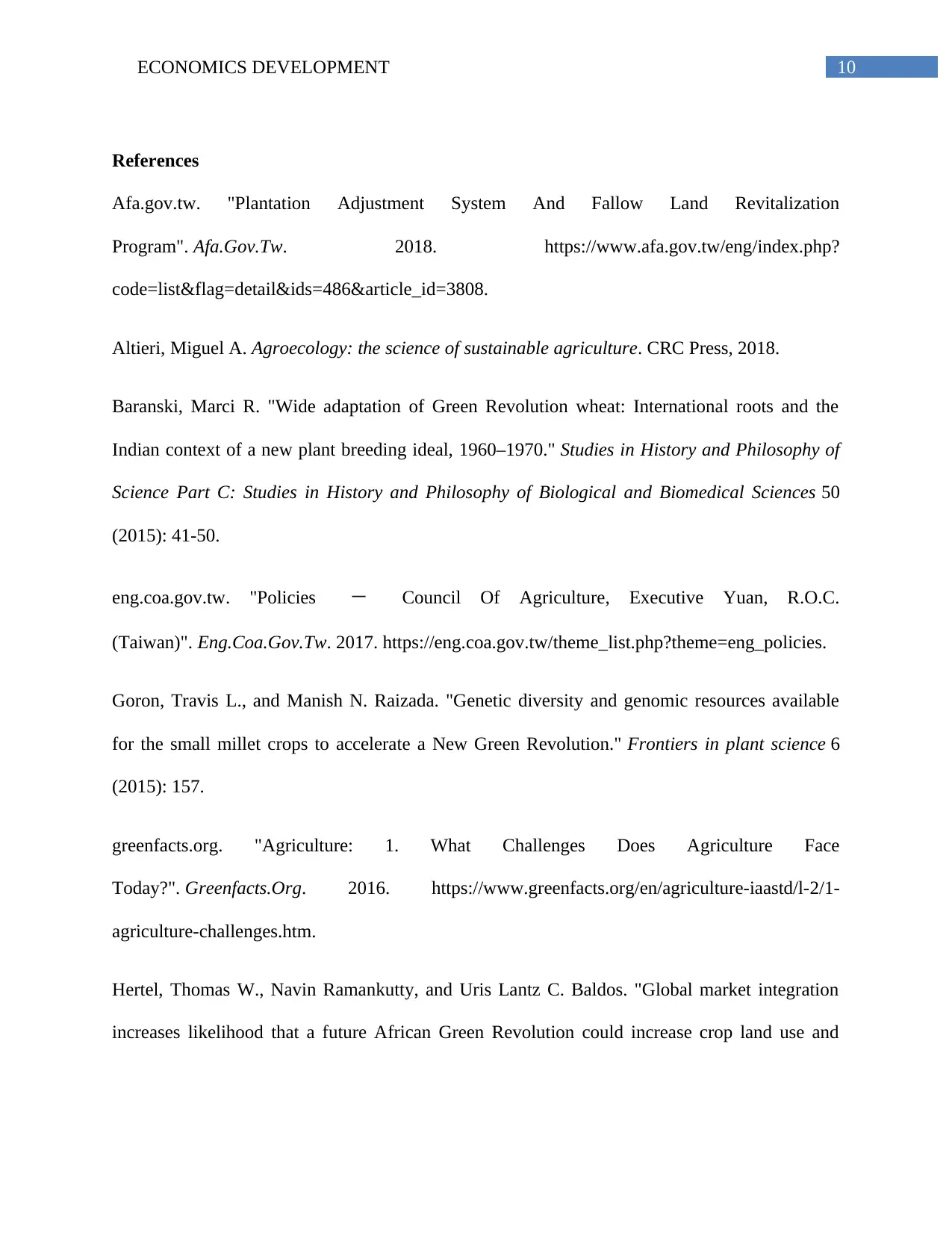
10ECONOMICS DEVELOPMENT
References
Afa.gov.tw. "Plantation Adjustment System And Fallow Land Revitalization
Program". Afa.Gov.Tw. 2018. https://www.afa.gov.tw/eng/index.php?
code=list&flag=detail&ids=486&article_id=3808.
Altieri, Miguel A. Agroecology: the science of sustainable agriculture. CRC Press, 2018.
Baranski, Marci R. "Wide adaptation of Green Revolution wheat: International roots and the
Indian context of a new plant breeding ideal, 1960–1970." Studies in History and Philosophy of
Science Part C: Studies in History and Philosophy of Biological and Biomedical Sciences 50
(2015): 41-50.
eng.coa.gov.tw. "Policies - Council Of Agriculture, Executive Yuan, R.O.C.
(Taiwan)". Eng.Coa.Gov.Tw. 2017. https://eng.coa.gov.tw/theme_list.php?theme=eng_policies.
Goron, Travis L., and Manish N. Raizada. "Genetic diversity and genomic resources available
for the small millet crops to accelerate a New Green Revolution." Frontiers in plant science 6
(2015): 157.
greenfacts.org. "Agriculture: 1. What Challenges Does Agriculture Face
Today?". Greenfacts.Org. 2016. https://www.greenfacts.org/en/agriculture-iaastd/l-2/1-
agriculture-challenges.htm.
Hertel, Thomas W., Navin Ramankutty, and Uris Lantz C. Baldos. "Global market integration
increases likelihood that a future African Green Revolution could increase crop land use and
References
Afa.gov.tw. "Plantation Adjustment System And Fallow Land Revitalization
Program". Afa.Gov.Tw. 2018. https://www.afa.gov.tw/eng/index.php?
code=list&flag=detail&ids=486&article_id=3808.
Altieri, Miguel A. Agroecology: the science of sustainable agriculture. CRC Press, 2018.
Baranski, Marci R. "Wide adaptation of Green Revolution wheat: International roots and the
Indian context of a new plant breeding ideal, 1960–1970." Studies in History and Philosophy of
Science Part C: Studies in History and Philosophy of Biological and Biomedical Sciences 50
(2015): 41-50.
eng.coa.gov.tw. "Policies - Council Of Agriculture, Executive Yuan, R.O.C.
(Taiwan)". Eng.Coa.Gov.Tw. 2017. https://eng.coa.gov.tw/theme_list.php?theme=eng_policies.
Goron, Travis L., and Manish N. Raizada. "Genetic diversity and genomic resources available
for the small millet crops to accelerate a New Green Revolution." Frontiers in plant science 6
(2015): 157.
greenfacts.org. "Agriculture: 1. What Challenges Does Agriculture Face
Today?". Greenfacts.Org. 2016. https://www.greenfacts.org/en/agriculture-iaastd/l-2/1-
agriculture-challenges.htm.
Hertel, Thomas W., Navin Ramankutty, and Uris Lantz C. Baldos. "Global market integration
increases likelihood that a future African Green Revolution could increase crop land use and
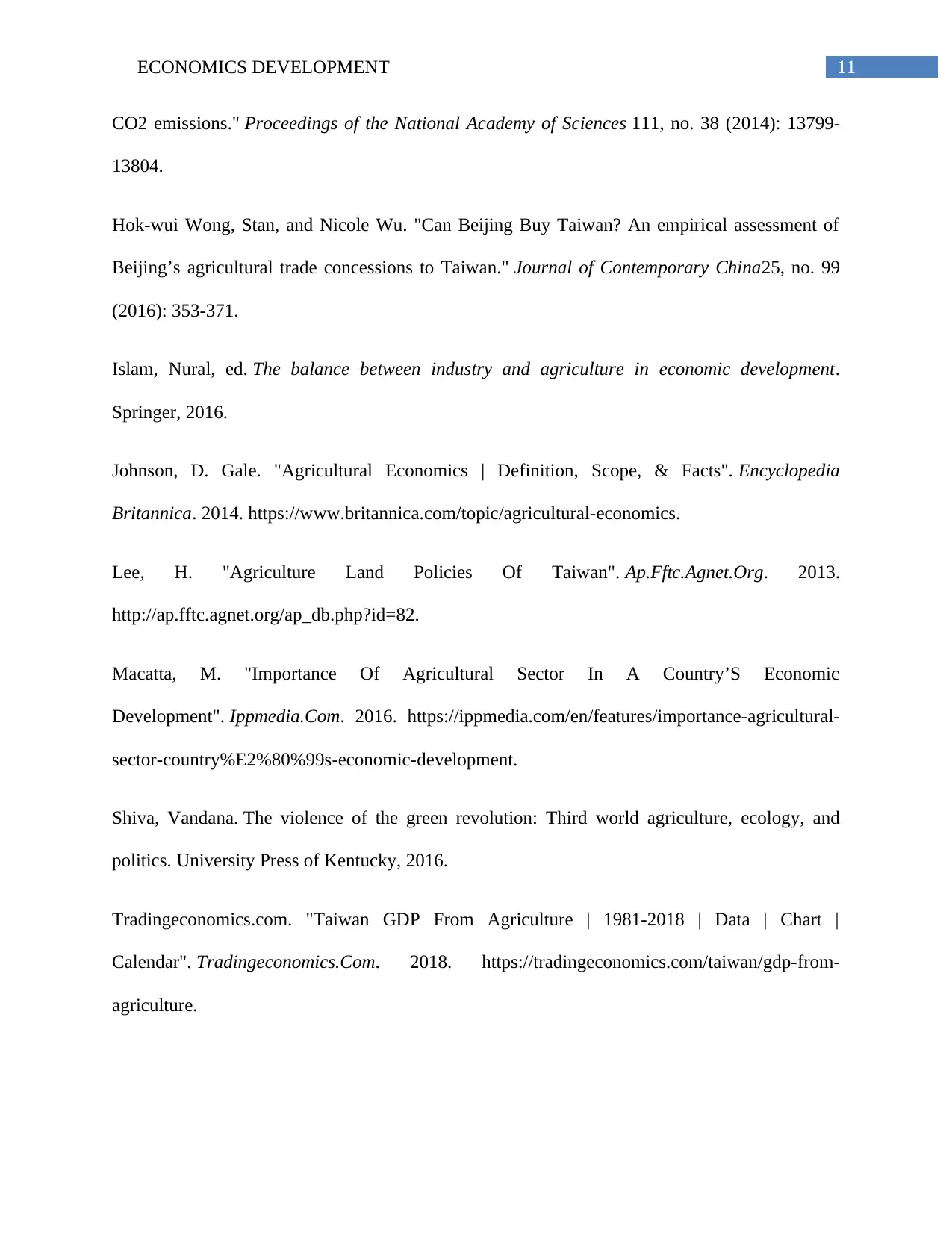
11ECONOMICS DEVELOPMENT
CO2 emissions." Proceedings of the National Academy of Sciences 111, no. 38 (2014): 13799-
13804.
Hok-wui Wong, Stan, and Nicole Wu. "Can Beijing Buy Taiwan? An empirical assessment of
Beijing’s agricultural trade concessions to Taiwan." Journal of Contemporary China25, no. 99
(2016): 353-371.
Islam, Nural, ed. The balance between industry and agriculture in economic development.
Springer, 2016.
Johnson, D. Gale. "Agricultural Economics | Definition, Scope, & Facts". Encyclopedia
Britannica. 2014. https://www.britannica.com/topic/agricultural-economics.
Lee, H. "Agriculture Land Policies Of Taiwan". Ap.Fftc.Agnet.Org. 2013.
http://ap.fftc.agnet.org/ap_db.php?id=82.
Macatta, M. "Importance Of Agricultural Sector In A Country’S Economic
Development". Ippmedia.Com. 2016. https://ippmedia.com/en/features/importance-agricultural-
sector-country%E2%80%99s-economic-development.
Shiva, Vandana. The violence of the green revolution: Third world agriculture, ecology, and
politics. University Press of Kentucky, 2016.
Tradingeconomics.com. "Taiwan GDP From Agriculture | 1981-2018 | Data | Chart |
Calendar". Tradingeconomics.Com. 2018. https://tradingeconomics.com/taiwan/gdp-from-
agriculture.
CO2 emissions." Proceedings of the National Academy of Sciences 111, no. 38 (2014): 13799-
13804.
Hok-wui Wong, Stan, and Nicole Wu. "Can Beijing Buy Taiwan? An empirical assessment of
Beijing’s agricultural trade concessions to Taiwan." Journal of Contemporary China25, no. 99
(2016): 353-371.
Islam, Nural, ed. The balance between industry and agriculture in economic development.
Springer, 2016.
Johnson, D. Gale. "Agricultural Economics | Definition, Scope, & Facts". Encyclopedia
Britannica. 2014. https://www.britannica.com/topic/agricultural-economics.
Lee, H. "Agriculture Land Policies Of Taiwan". Ap.Fftc.Agnet.Org. 2013.
http://ap.fftc.agnet.org/ap_db.php?id=82.
Macatta, M. "Importance Of Agricultural Sector In A Country’S Economic
Development". Ippmedia.Com. 2016. https://ippmedia.com/en/features/importance-agricultural-
sector-country%E2%80%99s-economic-development.
Shiva, Vandana. The violence of the green revolution: Third world agriculture, ecology, and
politics. University Press of Kentucky, 2016.
Tradingeconomics.com. "Taiwan GDP From Agriculture | 1981-2018 | Data | Chart |
Calendar". Tradingeconomics.Com. 2018. https://tradingeconomics.com/taiwan/gdp-from-
agriculture.
⊘ This is a preview!⊘
Do you want full access?
Subscribe today to unlock all pages.

Trusted by 1+ million students worldwide
1 out of 14
Related Documents
Your All-in-One AI-Powered Toolkit for Academic Success.
+13062052269
info@desklib.com
Available 24*7 on WhatsApp / Email
![[object Object]](/_next/static/media/star-bottom.7253800d.svg)
Unlock your academic potential
Copyright © 2020–2025 A2Z Services. All Rights Reserved. Developed and managed by ZUCOL.





